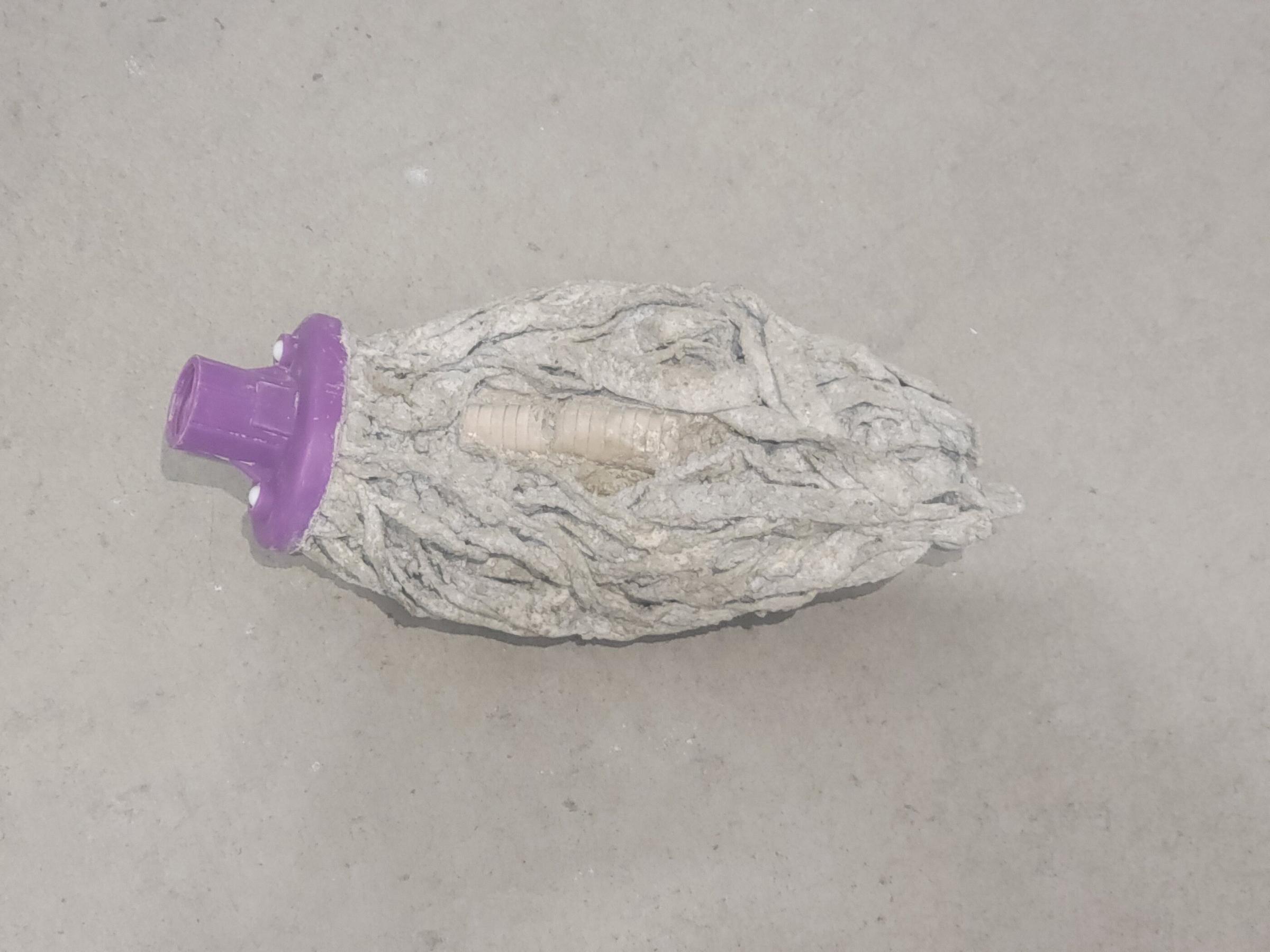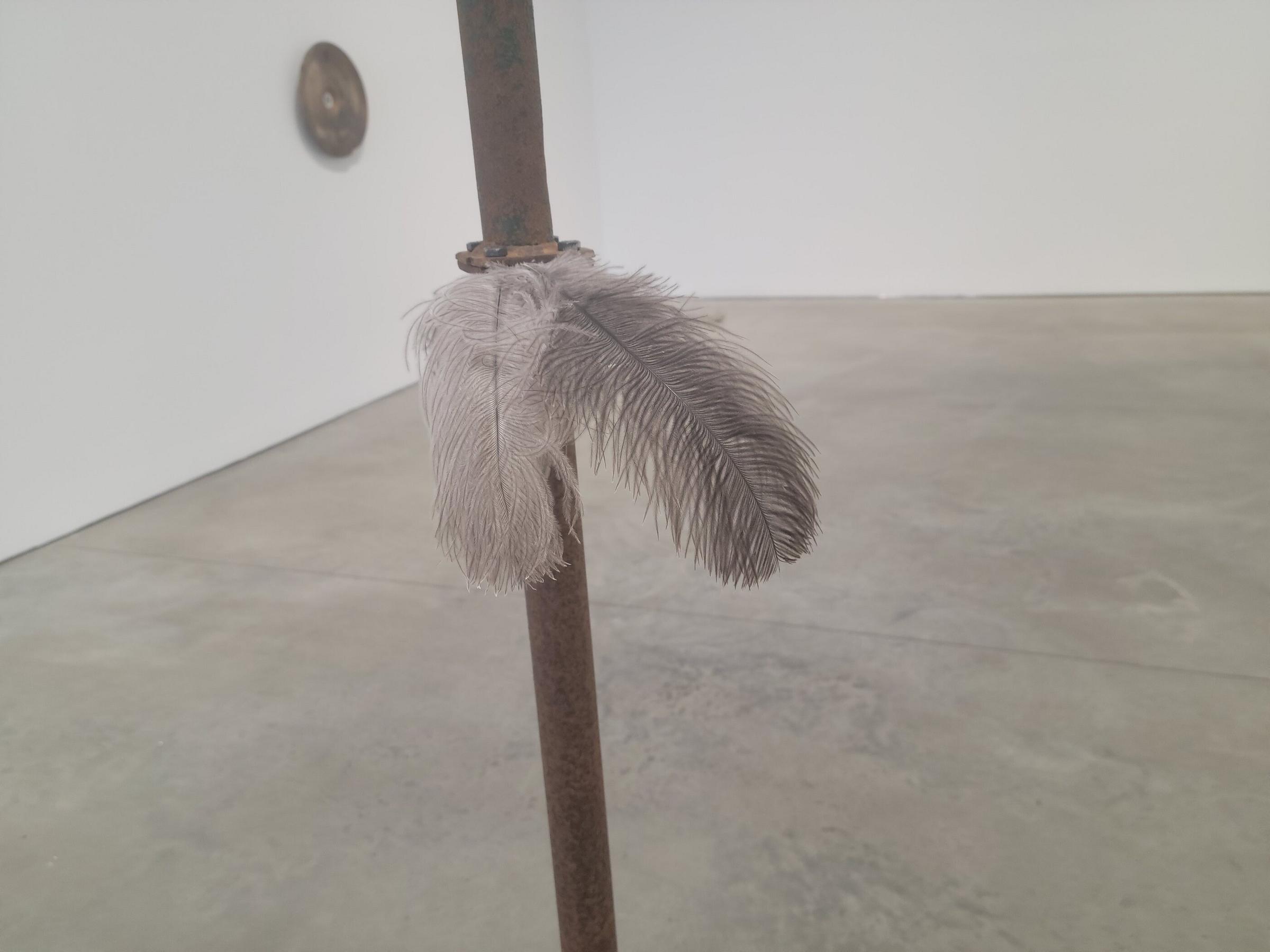The Dust of Human Life, & The Art Of Conversations

NINA CANELL: MOTHER OF DUST
303 Gallery
555 West 21st Street, New York, NY
Through Oct. 21
What’s your reaction to the above-pictured piece of art?
My initial response to this grey, dried-out mophead, not behind glass, not on a plinth, but simply lying on the floor, was to laugh and say, “Are you kidding me?” It’s priced at €16,000.
But there was something arresting about the object and Nina Canell’s entire solo exhibition Mother of Dust that compelled me to return to 303 Gallery, for a closer look.
The experience reminded me of that person whom you dislike when you first meet. But when you actually listen and think more about what he’s saying and doing — he becomes one of your most intriguing and oddly attractive friends.
Ideas behind the object, more than the piece itself, often drive conceptual art. These works inevitably become the art of conversations.
In discussing Crynoid (the mophead sculpture), two gallery visitors separately referenced an incident where someone put his glasses on the floor at a museum and people started taking pictures, thinking it was installation art. Other people said it reminded them of Marcel Duchamp’s porcelain urinal, Fountain (1917).
In “What Art Is,” Arthur C. Danto wrote, “Duchamp’s philosophical discovery was that art could exist, and that its importance was that it had no aesthetic distinction to speak of, at a time when it was widely believed that aesthetic delectation was what art was all about.”
But beauty is in the eye of the beholder.
“You don’t see it as a mop. You appreciate the color and the form, and looking at objects in a different context,” said visitor Andrew Teoh.
Unlike Duchamp’s readymades, Crynoid is far from a prefabricated, mass-produced, mop tossed on the floor. Cast in concrete, the artwork resembles a petrified rock. A mophead grasps within its stone-like, Medusa locks, a fossilized crinoid from Sweden, the country where the Berlin-based artist was born. Crinoids date back to the Paleozoic Era, predating dinosaurs by 300 million years, according to the British Geological Survey. The plant-like marine animals have feathery arms, a subtle wink to Canell’s feather duster piece, titled Hold. Looking more closely at Crynoid, an observer can see the spine-like stem of the crinoid encrusted in the tangle of mop strands.
“When I see a mophead dipped in concrete, the idea of the weight of having to clean house from head to toe on a Sunday comes to mind,” said visitor Jessica Drago.

“It’s very playful, experimental, trying to push ideas of what is art and what is very everyday stuff,” said visitor Civit Min.
303 Gallery Associate Director Julia Moody said Canell’s sculptures imagine the remnants of today’s industrial culture as part of the fossils humans leave behind. Energy, minerals, animals, technology and the landscapes of histories are all themes in her contemporary anthropological art.
Visitor Glenn Wosettler said that he appreciated the conversations among the different pieces that unified the show. He and visitor Jeff Schwarz agreed that Pebble Conveyor, in which a stone rolls in perpetual motion, reminded them of the fate of Sisyphus.
Anchoring the exhibition, a table rigged with a conveyor belt, Mother of Dust, simulates a broom sweeping pearls, in another continual Sisyphean drama. It’s priced at €95,000.
Visitor Sarah Tortorich, a registrar at a Lower East Side gallery, ironically commented about the actual work behind the exhibition about work. “Shipping this, installing this really must have been not fun,” she stated, looking at the more than 23-foot long sculpture.
Danto wrote, “Much of contemporary art is hardly aesthetic at all but it has in its stead the power of meaning and the possibility of truth, and depends upon the interpretation that brings these into play.”
The show had a focus on dust. I’ve often heard that the atoms in the human body were created in stars before the Earth was formed. We are made of stardust. Watching Mother of Dust made me wonder whether it was a metaphor of God’s shepherding humans, like dust in the universe. It reminded me of a loving, responsible mother, watching over her children, brushing them along as they bobble through life.
303 Gallery states in its release, “Each particle of dust represents a beat in the history of movement.”
Movement is the hubbub of life with dust and detritus, with change being our only constant.
Is the broom sweeper each of us, with each pearl, an iridescent particle of our infinite dust of every thought, every smile, every laugh, every heartbreak, every emotion, everything that makes us human, in every moment while we are alive, breathing and moving?
Maybe Canell is reminding us to treasure every pearl of dust that we’re so busy, routinely sweeping away.
Where I’m going next: Something Beautiful: Reframing La Colección at El Museo del Barrio.






